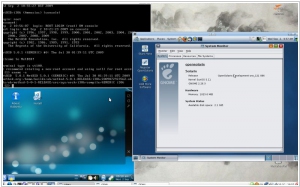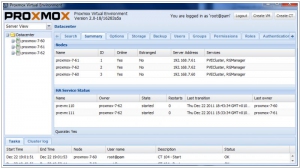KVM vs Proxmox
May 28, 2023 | Author: Michael Stromann
16

KVM (for Kernel-based Virtual Machine) is a full virtualization solution for Linux on x86 hardware containing virtualization extensions (Intel VT or AMD-V). It consists of a loadable kernel module, kvm.ko, that provides the core virtualization infrastructure and a processor specific module, kvm-intel.ko or kvm-amd.ko. KVM also requires a modified QEMU although work is underway to get the required changes upstream.
KVM (Kernel-based Virtual Machine) and Proxmox are both popular virtualization technologies used to create and manage virtual machines. However, there are key differences between them.
KVM is a virtualization solution that is built into the Linux kernel. It leverages hardware-level virtualization extensions in modern processors to provide efficient and secure virtualization capabilities. KVM allows you to run multiple virtual machines on a single physical host and supports a wide range of operating systems. It provides strong isolation between virtual machines and offers high performance. KVM is typically used in combination with other tools or management frameworks to create and manage virtual machines.
Proxmox, on the other hand, is a complete virtualization management platform that utilizes KVM as its underlying hypervisor. It combines KVM virtualization with container-based virtualization (LXC) to provide a comprehensive solution for running and managing virtual machines and containers. Proxmox offers a web-based management interface that allows you to create, configure, and monitor virtual machines and containers. It also provides features such as live migration, high availability, clustering, and backup/restore capabilities. Proxmox supports various storage options and includes built-in tools for managing networking and resource allocation.
The key difference between KVM and Proxmox is that KVM is a standalone hypervisor that provides the core virtualization capabilities, while Proxmox is a complete management platform that adds a user-friendly interface and additional features on top of KVM. Proxmox simplifies the management and deployment of virtual machines and containers, making it more accessible for administrators without extensive command-line knowledge.
See also: Top 10 Virtualization platforms
KVM is a virtualization solution that is built into the Linux kernel. It leverages hardware-level virtualization extensions in modern processors to provide efficient and secure virtualization capabilities. KVM allows you to run multiple virtual machines on a single physical host and supports a wide range of operating systems. It provides strong isolation between virtual machines and offers high performance. KVM is typically used in combination with other tools or management frameworks to create and manage virtual machines.
Proxmox, on the other hand, is a complete virtualization management platform that utilizes KVM as its underlying hypervisor. It combines KVM virtualization with container-based virtualization (LXC) to provide a comprehensive solution for running and managing virtual machines and containers. Proxmox offers a web-based management interface that allows you to create, configure, and monitor virtual machines and containers. It also provides features such as live migration, high availability, clustering, and backup/restore capabilities. Proxmox supports various storage options and includes built-in tools for managing networking and resource allocation.
The key difference between KVM and Proxmox is that KVM is a standalone hypervisor that provides the core virtualization capabilities, while Proxmox is a complete management platform that adds a user-friendly interface and additional features on top of KVM. Proxmox simplifies the management and deployment of virtual machines and containers, making it more accessible for administrators without extensive command-line knowledge.
See also: Top 10 Virtualization platforms



